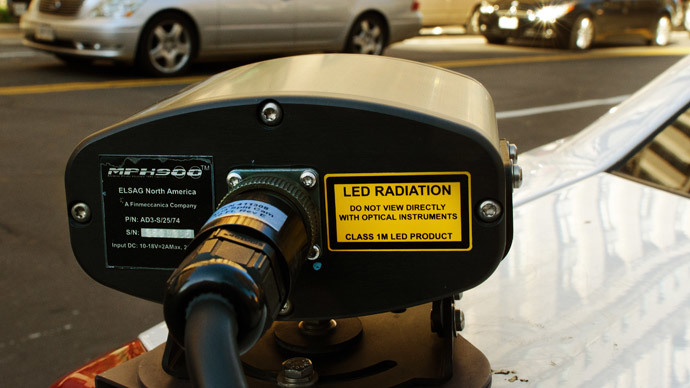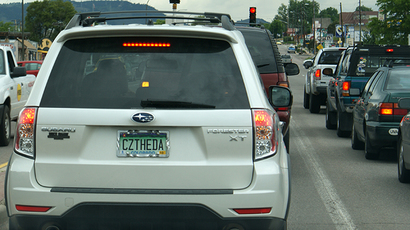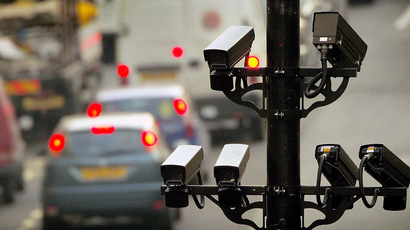Driver handcuffed at gunpoint over license plate-reader error

A California woman who was pulled over, handcuffed, and forced to kneel while at least four police officers pointed guns at her can sue the police department over their erroneous license plate reader result, a US federal judge ruled Monday.
Denise Green, who works for San Francisco as a municipal driver, first sued the police department for wrongful detention and excessive force after she was accosted in the March 2009 incident. US District Judge Richard Seeborg initially dismissed her suit, asserting that the police reasonably believed Green was a suspected car thief because of the information transmitted on a vehicle-mounted license plate reader.
The Ninth Circuit Court of Appeals felt otherwise, ruling that a jury should decide the case in no small part because the license plate read by the electronic reader was for “a car with a different make, model and color” than the 1992 Lexus ES300 that Green, a 45-year-old African American, was operating.
“A rational jury could find that (the officers and the city) violated Green’s fourth Amendment rights” prohibiting search and seizure, the court ruled unanimously, as quoted by the San Francisco Chronicle.
The license plate number on Green’s Lexus differed by only one digit from a truck that had been reported stolen. Officer Alberto Esparza admitted he was unable to see her plate or read the photo his camera captured, calling in to the police dispatch to verify that the number picked up was the same as the stolen vehicle.
Between four and six officers responded when the number was wrongly verified. Green was ordered out of her car, patted down, and placed in handcuffs for an estimated 10 minutes while the police combed through her vehicle. It was only when they scanned her true license plate number that the mistake was revealed.
The problem, according to the three member appeals court, was that it was common knowledge that the license plate reader was often wrong. Although it was not strict police policy, officers generally made visual confirmation in order to substantiate the reader’s accuracy. The judges also criticized the officers’ actions because Green was “visibly unthreatening” after being removed from her vehicle.
“During a portion of the time that the officers pointed their weapons at her, Green was handcuffed and secured; moreover, she weighed 250 pounds and was barely able to rise from her knees without assistance,” they wrote.
Michael Haddad, Green’s lawyer, told the Chronicle the suit should convince the department to revise its policing method.
“They have been automatically pointing guns anytime they believe a car was stolen,” he said.
Attorneys for the San Francisco police argued that their belief that the car was stolen was “in and of itself” enough justification for the amount of force, according to Ars Technica. The city is expected to take the case to trial.
This incident comes as the number of surveillance cameras, and vehicle mounted cameras in particular, is becoming increasingly relied upon by law enforcement agencies.
Last month in Prairie Village, Kansas, a man named Mark Molner was wrongfully identified as a car thief and boxed in by at least two police vehicles. Molner told the Prairie Village Post that his wife looked on from another vehicle as an officer walked up to his BMW with a weapon drawn.
“He did not point it at me, but it was definitely out of the holster,” Molner said of the gun. “I am guessing that he saw the shock and horror on my face, and realized that I was unlikely to make a scene.”
Privacy advocates have admitted concern not only with the number of cameras, but with the data they record. The same camera that records a license plate number also tracks the time, date and location while storing that information. Different police agencies keep the data stored for different amounts of time, whether it be days, weeks, or years.
Two years ago a Minneapolis Star Tribune reporter filed a request for his own license plate data records under the state’s open records law. The Minneapolis Police Department turned over an extensive list of dates and times indicating that on any given day over the course of a year the reporter’s car may have been filmed seven times.
“The technology that would make ‘1984’ possible in real life exists now,” Chuck Samuelson, executive director of the Minnesota American Civil Liberties Union, told the paper. “But the infrastructure to protect individuals’ privacies and rights doesn’t exist, particularly on the legislative and judicial side.”














